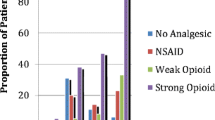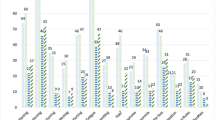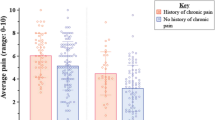Abstract
Background
This survey was performed to draw information on pain prevalence, intensity, and management from a sample of patients who were admitted to an oncologic center where a palliative care unit (PCU) has been established for 13 years.
Methods
Cross-sectional survey in an oncological department performed 1 day per month for six consecutive months.
Results
Of the 385 patients, 69.1, 19.2, 8.6, and 3.1 % had no pain, mild, moderate, and severe pain, respectively. Inpatients and patients with a low Karnofsky score showed higher levels of pain intensity (p < 0.0005). One hundred twenty-eight patients with pain or receiving analgesics were analyzed for pain management index (PMI). Only a minority of patients had negative PMI score, which was statistically associated with inpatient admission (p = 0.011). Fifty of these 128 patients had breakthrough pain (BTP), and all of them were receiving some medication for BTP.
Conclusion
It is likely that the presence of PCU team providing consultation, advices, and cultural pressure, other than offering admissions for difficult cases had a positive impact on the use of analgesics, as compared with previous similar surveys performed in oncological setting, where a PCU was unavailable. This information confirms the need of the presence of a PCU in a high volume oncological department.
Similar content being viewed by others

References
Apolone G, Corli O, Caraceni A et al (2009) Pattern and quality of care of cancer pain management. Results from the Cancer pain outcome research study group. Br J Cancer 100:1566–1574
Bandieri E, Sichetti D, Romero M, Fanizza C et al (2012) Impact of early access to a palliative/supportive care intervention on pain management in patients with cancer. Ann Oncol 23:2016–2020
Bruera E, Kuehn N, Miller MJ, Selmser P, Macmillan K (1991) The Edmonton Symptom Assessment System (ESAS): a simple method for the assessment of palliative care patients. J Palliat Care 7:6–9
Bruera E, Hui D (2011) Palliative care units: the best option for the most distressed. Arch Intern Med 171:1601
Cascinu S, Giordani P, Agostinelli R et al (2003) Pain and its treatment in hospitalized patients with metastatic cancer. Support Care Cancer 11:587–592
Cherny NI, Baselga J, de Conno F, Radbruch L (2009) Formulary availability and regulatory barriers to accessibility of opioids for cancer pain in Europe: a report from the ESMO/EAPC Opioid Policy Initiative. Ann Oncol 21:615–626
Cherny N (2010) The oncologist's role in delivering palliative care. Cancer J 16:411–422
Cleeland CS, Portenoy RK, Rue M et al (2005) Does an oral analgesic protocol improve pain control for patients with cancer? An intergroup study coordinated by the Eastern cooperative oncology group. Ann Oncol 16:972–980
Cleeland CS, Gonin R, Hatfield AK et al (1994) Pain and its treatment in outpatients with metastatic cancer. N Eng J Med 330:592–596
Deandrea S, Montanari M, Moja L et al (2008) Prevalence of undertreatment in cancer pain. A review of published literature. Ann Oncol 19:1985–1991
Di Maio M, Gridelli C, Gallo C et al (2004) Prevalence and management of pain in Italian patients with advanced non-small cell lung cancer. Br J Cancer 90:2288–2296
De Conno F, Ripamonti C, Brunelli C (2005) Opioid purchases and expenditure in nine western European countries: are we killing off morphine? Palliat Med 19:179–184
Marino I. Attuazione della legge 15.03.2010, n. 38 in materia di “terapia del dolore” presso le strutture ospedaliere. Commissione parlamentare di inchiesta sull’efficacia e l’efficienza del SSN. Italian Parliament.
Mercadante S (2007) Why are our patients still suffering pain? Nat Clin Pract Oncol 4:138–139
Mercadante S (1999) Pain treatment and outcome in advanced cancer patients followed at home. Cancer 85:1849–1858
Mercadante S, Fulfaro F (2005) World Health Organization guidelines for cancer pain: a reappraisal. Ann Oncol 16(Suppl 4):132–135
Mercadante S, Vitrano V (2010) Palliative care in Italy: problem areas emerging from the literature. Minerva Anestesiol 76:1060–1071
Mercadante S, Roila F, Berretto O, Labianca R, Casilini S; DOMAIN-AIOM study group (2008) Prevalence and treatment of cancer pain in Italian oncological wards centres: a cross-sectional survey. Support Care Cancer 16:1203–1211
Mercadante S, Villari P, Ferrera P (2003) A model of acute symptom control unit: pain relief and palliative care unit of La Maddalena Cancer Center. Support Care Cancer 11:114–119
Mercadante S, Villari P, Casuccio A (2011) An Italian survey on the attitudes in treating breakthrough cancer pain in hospice. Support Care Cancer 19:979–983
Mercadante S (2012) Pharmacotherapy for breakthrough cancer pain. Drugs 72:181–190
Mercadante S (2013) Opioid consumption depends on early palliative care in Italy. Ann Oncol 24:558
Mercadante S, Prestia G, Ranieri M, Giarratano A, Casuccio A (2013) Opioid use and effectiveness of its prescription at discharge in an acute pain relief and palliative care unit. Support Care Cancer 21:1853–1859
Moro C, Brunelli C, Miccinesi G, Fallai M et al (2006) Edmonton symptom assessment scale: Italian validation in two palliative care settings. Support Care Cancer 14:30–37
Serlin RC, Mendoza TR, Nakamura Y, Edwards KR, Cleeland CS (1995) When is cancer pain mild, moderate or severe? Grading pain severity by its interference with function. Pain 61:277–284
Ripamonti C, Zecca E, Brunelli C et al (2000) Pain experienced by patients hospitalized at the national cancer institute of Milan: research project “towards a pain-free hospital”. Tumori 86:412–418
Ripamonti C, Bandieri E, Roila F (2011) Management of cancer pain: ESMO clinical practice guidelines. Ann Oncol 22(Suppl 6):69–77
Van den Beuken-van Everdingen MHJ, De Rijke JM, Kessels AG et al (2007) Prevalence of pain in patients with cancer: a systematic review of the past 40 years. Ann Oncol 18:1437–1449
Disclosures
This paper did not receive any support. The authors have declared no conflicts of interest.
Author information
Authors and Affiliations
Corresponding author
Rights and permissions
About this article
Cite this article
Mercadante, S., Guccione, C., Di Fatta, S. et al. Cancer pain management in an oncological ward in a comprehensive cancer center with an established palliative care unit. Support Care Cancer 21, 3287–3292 (2013). https://doi.org/10.1007/s00520-013-1899-z
Received:
Accepted:
Published:
Issue Date:
DOI: https://doi.org/10.1007/s00520-013-1899-z



